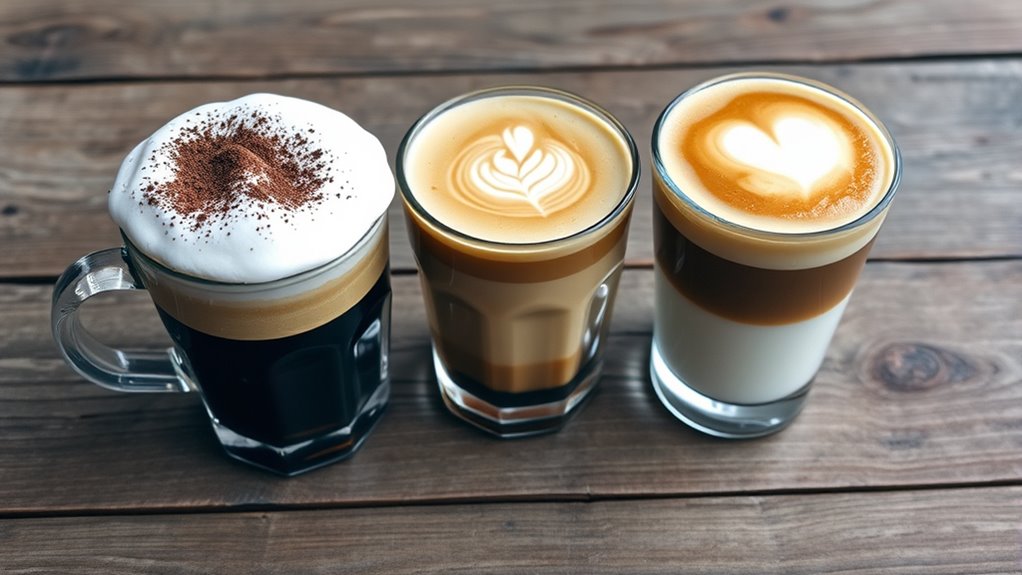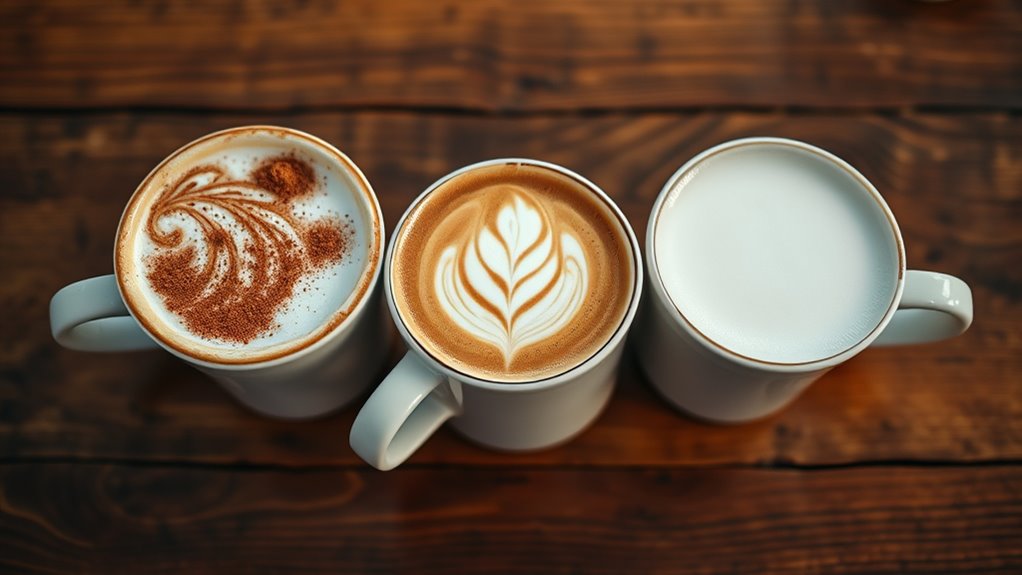Discover the key differences between a cappuccino, latte, and flat white. A cappuccino has equal parts espresso, steamed milk, and airy foam, offering a light, frothy texture. A latte uses more steamed milk for a smooth, velvety drink, while a flat white features a smaller amount of microfoam for a velvety surface with a hint of milk. Understanding these nuances will help you craft or choose each beverage confidently—exploring further reveals even more about their unique profiles.
Key Takeaways
- Cappuccinos have equal parts espresso, steamed milk, and airy foam, while lattes have more steamed milk and flat whites feature microfoam with less foam.
- The milk-to-coffee ratio is highest in lattes, moderate in cappuccinos, and lower in flat whites.
- Cappuccino foam is light and airy, latte microfoam is smooth and velvety, flat whites have fine, velvety microfoam with minimal foam.
- Bean origins influence flavor: Ethiopian or Colombian beans for cappuccino, Brazilian or Sumatran for latte, Australian/NZ for flat white.
- Serving temperatures and presentation styles emphasize each drink’s unique texture, flavor, and visual appeal.

Have you ever wondered what sets a cappuccino apart from a latte or a flat white? It all starts with the milk frothing techniques and the coffee bean origins. When you prepare a cappuccino, you’re aiming for a balance: equal parts espresso, steamed milk, and frothy milk foam. To achieve that signature airy foam, you need to master milk frothing techniques. You’ll want to start with fresh, cold milk—whole milk tends to produce the best froth because of its fat content, but you can experiment with alternatives. As you steam the milk, angle the pitcher just right and keep the steam wand near the surface to introduce air, creating microfoam. The goal is to get a creamy, velvety foam that holds its shape, with tiny bubbles that give it that light, airy texture. The origin of your coffee beans also plays a role. For a traditional cappuccino, baristas often select beans from regions like Ethiopia or Colombia, known for their bright, fruity notes or nutty undertones. The roasting level makes a difference too; medium roasts tend to bring out a balanced flavor that complements the milk foam without overpowering it. Additionally, the temperature at which you serve the drink can influence the overall taste experience.
When you look at a latte, the process shifts slightly. It features a shot of espresso topped with a larger amount of steamed milk, resulting in a creamier, less frothy drink. Here, milk frothing techniques focus on creating a smooth, velvety microfoam that blends seamlessly with the espresso. You still steam the milk the same way but aim for a more integrated texture, avoiding large bubbles or airy foam. The coffee bean origins for a latte might lean toward beans with richer, chocolatey profiles, often from regions like Brazil or Sumatra. These beans provide a full-bodied base that complements the milk’s sweetness and creates a mellow, comforting drink. Since lattes are usually larger, the milk-to-coffee ratio is higher, making the milk’s quality and texture *paramount* for the overall flavor.
A flat white falls somewhere between the two. It uses a shot of espresso with a smaller amount of steamed milk and a thin layer of microfoam—more akin to a latte but with a creamier, silkier texture. Your milk frothing techniques should focus on creating fine, consistent microfoam, which involves slightly less air incorporation than for a cappuccino. Origin-wise, flat whites often feature beans from Australia or New Zealand, emphasizing smooth, balanced flavors that shine through the minimal milk. The key difference is how you handle the milk: for a flat white, you want to pour the milk in a way that results in a velvety surface, allowing the espresso’s flavor to peek through without the heavy foam found in cappuccinos. Mastering milk frothing techniques is essential to achieve the ideal texture for each beverage.
In essence, understanding milk frothing techniques and coffee bean origins helps you craft each drink to perfection. Whether you prefer the airy foam of a cappuccino, the creamy richness of a latte, or the silky smoothness of a flat white, mastering these details elevates your coffee experience.
Frequently Asked Questions
Which Coffee Has the Highest Caffeine Content?
You’ll find that a latte generally has the highest caffeine content among the three, thanks to its larger serving size. Caffeine concentration varies with brewing impact, so a flat white’s espresso shot is more concentrated but smaller, while a cappuccino’s froth slightly dilutes the caffeine. Overall, the caffeine level depends on shot size and preparation, but a larger latte usually delivers the most caffeine per serving.
Are There Health Benefits Associated With Each Coffee Type?
You’ll find that each coffee type offers health benefits, thanks to their antioxidant levels. Drinking a cappuccino, latte, or flat white can boost your immune system and improve mood, but moderation is key. The health impact varies depending on added sugars or fats. Generally, enjoying these coffees in moderation helps you harness their antioxidants while avoiding negative effects like excess caffeine, which can cause jitters or sleep issues.
How Do Brewing Methods Affect Flavor Differences?
Did you know that brewing techniques can influence flavor profiles by up to 70%? When you use different methods—like espresso extraction, steaming milk, or pour-over—you directly impact the taste and aroma of your coffee. For example, a rich espresso emphasizes bold, intense flavors, while a slow pour-over highlights nuanced, delicate notes. Your choice of brewing technique shapes the overall flavor experience, making each cup uniquely yours.
Which Drink Is Most Popular Globally?
You’ll find that the latte is the most popular globally, thanks to its smooth, milky flavor appealing to many tastes. Its widespread popularity is driven by regional preferences, especially in North America and Europe, where it’s a café staple. While flat whites gain popularity in Australia and New Zealand, and cappuccinos remain favored in some European countries, the latte’s versatility makes it the top choice worldwide.
Can These Coffees Be Customized With Alternative Milk Options?
Of course, you can customize these coffees with alternative milk options—because who needs tradition when you can have almond, soy, or oat milk? Flavor customization is a breeze, letting you craft a drink that’s uniquely yours. So go ahead, indulge in your whims, and turn your cup into a personalized, lactose-free masterpiece. After all, coffee should be as flexible as your mood—and your dietary choices.
Conclusion
Now that you know the differences between a cappuccino, latte, and flat white, which one will you choose for your next coffee break? Each offers a unique taste experience, from the frothy richness to smooth creaminess. So, next time you’re craving a coffee, ask yourself: are you in the mood for bold foam, milky comfort, or a perfect balance? Whatever you pick, you’re in for a delicious treat!









